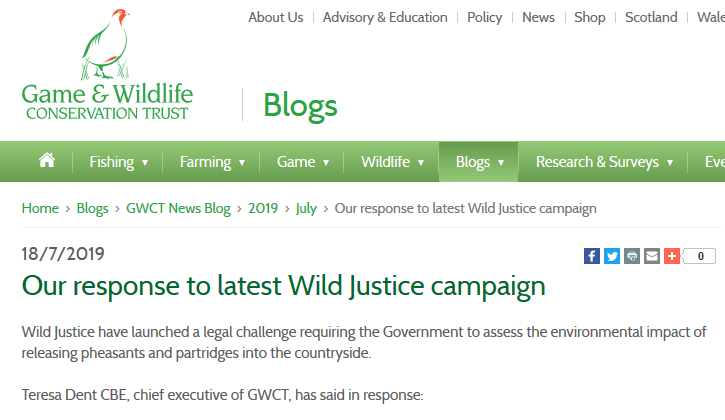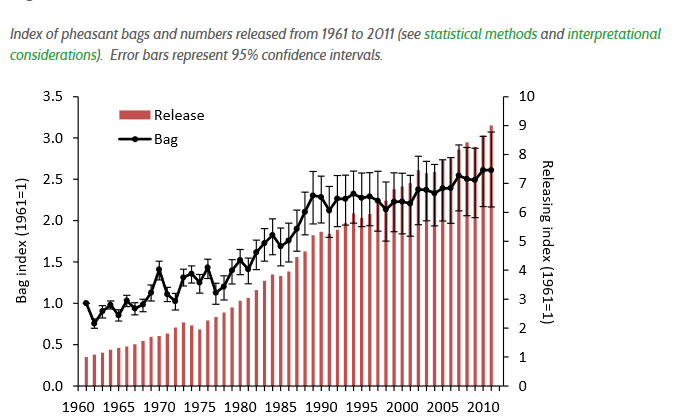GWCT stung into limp, unconvincing defence of their members.

GWCT is clearly rattled by the Wild Justice legal challenge – even though it is to Defra. Rarely do we hear the thoughts of GWCT Chief Exec Teresa Dent; we only usually get the spin of her right hand man, Mr Gilruth. So it must be something momentous to get Teresa to utter.
This is what she said;
We [GWCT] found that the releasing of lowland gamebirds can be done in a way that minimises or avoids negative effects on habitats and other wildlife, and maximises the potential of management practices associated with releasing to deliver broader biodiversity benefit.
https://www.gwct.org.uk/blogs/news/2019/july/our-response-to-latest-wild-justice-campaign/
Well, was that really worth waiting for…?
The critical word above is a small one – the word ‘can’.
I ‘can’ live a life of perfection, in theory, but ‘do’ I?
The GWCT ‘can’ speak without a forked tongue – but ‘does’ it?
Natural England, of which Teresa is a Board member, ‘can’ use all its might and power to conserve the Hen Harrier, but ‘does’ it?
So, yes, Pheasant releases, in another and wholly imaginary world, ‘can’ be done in a way that minimises or avoids negative effects (how wise to admit that negative effects exist) but are they?
Elsewhere on the GWCT website you will find more concrete evidence for harm, from their own work – this is (as I said in my recent British Birds paper) a good summary of the situation:
There are legitimate questions relating to the release of pheasants for shooting and impacts on habitats and wildlife. The Game & Wildlife Conservation Trust research in this area over the last decade or so has been substantial but has still tackled only some of the issues. It has highlighted so far a number of possible unwanted impacts, which are usually a result of the released birds themselves, and a number of positive effects, which are usually associated with habitat management work for game.
The impact of pheasant releases: balancing the positive with the negative
Unwanted impacts that are usually a result of the birds themselves – and the number of birds being released has increased dramatically, as best illustrated by this graph from the GWCT website;

How high is that graph in 2019? I’m pretty sure that it is higher than when this graph stops in 2010. How odd that GWCT haven’t updated it.
There is plenty more one could say, but let us just point out that Teresa relies on shoots sticking to the Guidelines for Sustainable Gamebird Releasing. These are the GWCT’s guidelines – not government guidelines, and not enforced in any way. But maybe GWCT members (and everyone else flinging Pheasants into the countryside) is a paragon of virtue when it comes to sticking to the guidelines? How likely do you think that is?
Well the GWCT themselves give us part of the answer here;
The GWCT suggest that around 700 birds per hectare of release pen is an appropriate stocking level (Sage & Swan, 2003) but releases in the order of 8,000 birds per hectare of release pen, have been documented. The mean stocking density reported in Sage et al. (2005) is currently 1,800 birds per hectare of pen.
https://www.gwct.org.uk/game/research/species/pheasant/releasing-for-shooting-in-lowland-habitats/
The recommended stocking density is 700/ha but the average is more than twice as high as that (1800/ha) with an admitted example of more than ten times the recommendation (8000/ha). What a great example of self-regulation by Pheasant shooters. It’s a good job GWCT members aren’t ‘self-regulating’ on drink-driving isn’t it?
The Wild Justice legal challenge asks Defra to comply with the Habitats Directive and assess the impacts of Pheasants – such examples will make any independent assessment take a closer look at everything else going on in the world of Pheasant shooting. And rightly so.
And here is our crowdfunding page asking for your support, please, so that we can take this case through the courts.
